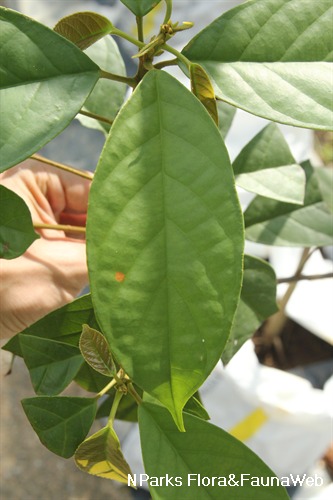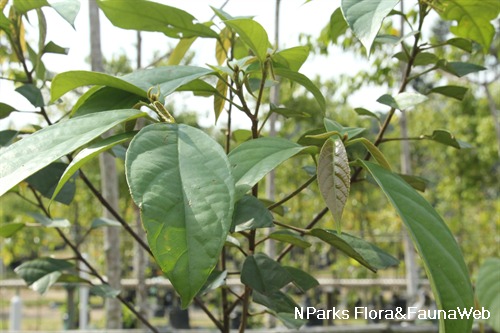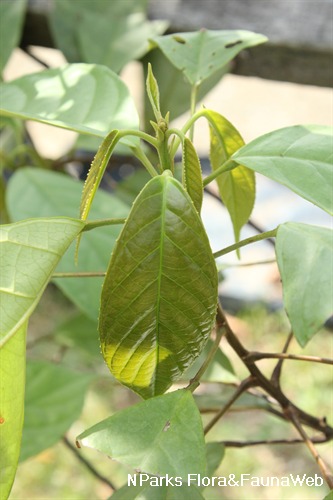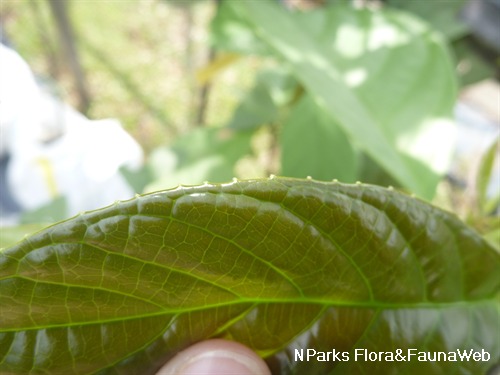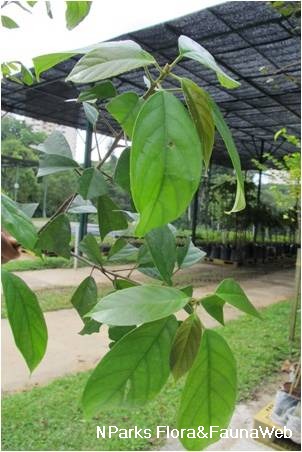
Back
Baccaurea pyriformis Gage
| Family Name: | Phyllanthaceae |
| Common Name: | Fig Tampoi, Tampoi Burung, Tampoi Tangau |
Name
Classifications and Characteristics
| Plant Division | Angiosperms (Flowering Seed Plants) |
|---|---|
| Plant Growth Form | Tree (Medium (16m-30m)) |
| Lifespan (in Singapore) | Perennial |
| Mode of Nutrition | Autotrophic |
| Plant Shape | Irregular |
| Maximum Height | 30 m |
Biogeography
| Native Distribution | Sumatra, Peninsular Malaysia, Singapore, and Borneo |
|---|---|
| Native Habitat | Terrestrial (Primary Rainforest, Inland Cliff) |
| Preferred Climate Zone | Tropical |
| Local Conservation Status | Native to Singapore (Critically Endangered (CR)) |
Description and Ethnobotany
| Growth Form | It is a tree up to 30 m tall. This species resembles the blue rambai (Baccaurea bracteata) but the twigs and stalks are finely velvety and not smooth. |
|---|---|
| Foliage | Its alternate, long-stalked leaves have papery to leathery leaf blades that are oval-egg-shaped, purple when young, and up to 20 by 8 cm. Its leaf stalks are finely velvety. |
| Flowers | Its male flowers are yellowish to pale brown, 1–2 mm wide, and found in clusters up to 7.5 cm long. Its female flowers are dirty brown, 2.5–3.5 mm wide, and found in clusters up to 3 cm long. |
| Fruit | Its fruits are yellowish- to orange-brown, round, fig- or pear-shaped, and up to 38 by 34 mm. The fruits are found in bunches on the branches below the leaves. Each fruit contains 2 or 3 seeds in orange-red pulp. Its oval seeds are laterally flattened and 8–18 by 5–12 mm. |
| Habitat | It grows in lowland forests. |
| Associated Fauna | Its flowers are insect pollinated and the fruits are eaten by small mammals. |
| Cultivation | It can be propagated by seed. |
| Etymology | Latin Bacca, berry; Latin aurea, golden, referring to the colour of the berries; Latin pyriformis means pear-shaped, referring to the plant’s fruits |
| Ethnobotanical Uses | Edible Plant Parts : Edible Fruits Food (Fruit or Vegetable) |
Landscaping Features
| Landscaping | It may be suitable for parks or gardens for its attractive young foliage and edible fruits. |
|---|---|
| Desirable Plant Features | Ornamental Foliage, Ornamental Fruits |
| Landscape Uses | General, Parks & Gardens, Small Gardens |
Fauna, Pollination and Dispersal
| Pollination Method(s) | Biotic (Fauna) |
|---|---|
| Seed or Spore Dispersal | Biotic (Fauna) |
Plant Care and Propagation
| Light Preference | Full Sun, Semi-Shade |
|---|---|
| Water Preference | Moderate Water |
| Plant Growth Rate | Moderate |
| Rootzone Tolerance | Moist Soils, Fertile Loamy Soils |
| Propagation Method | Seed |
Foliar
| Foliage Retention | Evergreen |
|---|---|
| Mature Foliage Colour(s) | Green |
| Mature Foliage Texture(s) | Papery, Leathery |
| Prominent Young Flush Colour(s) | Purple |
| Young Flush Texture(s) | Papery, Leathery |
| Foliar Type | Simple / Unifoliate |
| Foliar Arrangement Along Stem | Alternate |
| Foliar Attachment to Stem | Petiolate |
| Foliar Shape(s) | Non-Palm Foliage (Ovate, Elliptical) |
| Foliar Venation | Pinnate / Net |
| Foliar Margin | Entire |
Floral (Angiosperm)
| Flower & Plant Sexuality | Unisexual Flowers , Monoecious |
| Flower Colour(s) | Brown, Yellow / Golden |
|---|
| Flower Grouping | Cluster / Inflorescence |
| Inflorescence Type | Raceme |
Fruit, Seed and Spore
| Mature Fruit Colour(s) | Brown, Orange, Yellow / Golden |
|---|---|
| Fruit Classification | Simple Fruit |
| Fruit Type | Dehiscent Dry Fruit , Capsule |
Image Repository
Others
| Master ID | 31327 |
|---|---|
| Species ID | 5724 |
| Flora Disclaimer | The information in this website has been compiled from reliable sources, such as reference works on medicinal plants. It is not a substitute for medical advice or treatment and NParks does not purport to provide any medical advice. Readers should always consult his/her physician before using or consuming a plant for medicinal purposes. |

